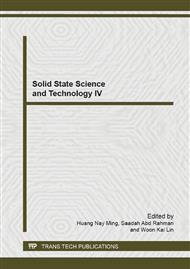p.447
p.452
p.460
p.477
p.481
p.490
p.500
p.505
p.509
Morphological Distinctions on CdSe QDs Synthesized via Auto Clave and Organometallic Route
Abstract:
Quantum dots (QDs) semiconductors exhibit size-dependent Opto-electronic properties and customizable bandgaps that can be engineered to match the solar spectrum [. Organometallic synthetic approach relies on the injection of organometallic precursor into a pyrolyphic mixture at elevated temperature sufficient enough to initiate particle growth. This approach entails precise control of temperature gradient [. Organometallic reagents injected into a heated non-coordinating octadecene (ODE) were compatible with oleic acid (OA) that was used to protect the CdSe QDs against oxidation and emission loss. ODE is stable in air and has a low melting point (below 20 oC) making it easier to be handled at room temperature. Its high boiling point (about 360 oC) coupled with its inert nature, less toxicity, low cost and good dissolving power makes it an ideal solvent for the growth of CdSe QDs [3,4,5 and 6]. However, QDs synthetic methods differ and relies on how the thermodynamic properties of the reactant mixtures are varied. QDs nucleation growth depicted the underlying processes occurring in aqueous solution and the need to control thermodynamic variables such as reaction time and temperature of the reactants as well as non-thermodynamic variable such as stirring speeds.
Info:
Periodical:
Pages:
481-489
Citation:
Online since:
February 2014
Price:
Сopyright:
© 2014 Trans Tech Publications Ltd. All Rights Reserved
Share:
Citation:


